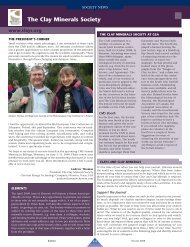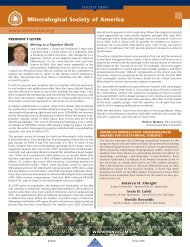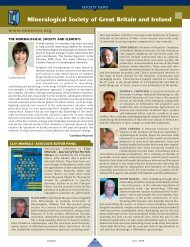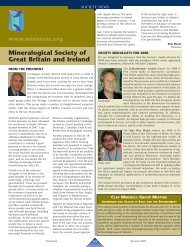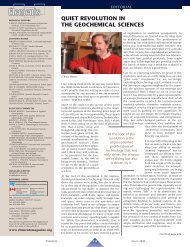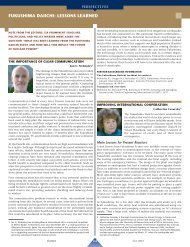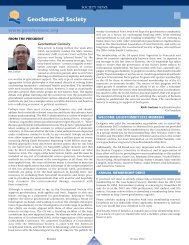MinerSoc - Elements Magazine
MinerSoc - Elements Magazine
MinerSoc - Elements Magazine
- No tags were found...
You also want an ePaper? Increase the reach of your titles
YUMPU automatically turns print PDFs into web optimized ePapers that Google loves.
Lochaber Geopark – Ardnamurchan LighthouseTaigh Solas Aird nam MurchanArdnamurchan Point, in the Lochaber district of western Scotland, isthe most westerly point of mainland Britain, at 6°13’ W. The lighthouse,designed by Alan Stevenson, of the celebrated Stevenson family of engineers,was opened in 1849. It is constructed of beautifully fitted, curvedblocks of granite from the Ross-of-Mull, dovetailed in three dimensions.It stands on hypersthene gabbros of Centre 2 of the PalaeogeneArdnamurchan Central Complex, with its dramatic ring structures, andprovides stunning views of the plutonic centres of the islands of Rumand Skye and the lavas of Eigg and Mull.As elsewhere in Scotland, the great light now runs automatically. Thebuildings have been developed as a visitor centre by ArdnamurchanLighthouse Trust, who approached the Lochaber Geopark Association,part of the European Geoparks Network, to establish a geological displayin one of the outbuildings. LGA is a charity, with most of its interpretativeand educational work done by volunteers like myself, and MinSocvery kindly provided £500 towards display cabinets for local mineral,rock and fossil specimens. Motorists approaching Ardnamurchan fromthe east pass through Strontian, where they see a board bearing the words‘Strontian, the village that gave its name to the element Strontium’ (see<strong>Elements</strong> 4: 216). We have assembled samples from the mines, includingstrontianite and brewsterite from this type locality, as well as examplesof the rock types of the Ardnamurchan complex. Motorists can also arriveon the ferry from Tobermory, on Mull, to Kilchoan, a journey that is perhapsunique because both villages have minerals named after them!Senior Bursary ReportInternational Discussion Meeting on ContinentalGeology and Tectonics – Xi’an, China, September 2009In 1993, when I visited the fledgling Earth Sciences Department atthe University of Hong Kong, it was pointed out to me that Chinawas virtually untouched by modern geological research and thatthere were “easily 300 PhDs out there, waiting to be done”. Muchhas changed in the intervening 16 years, and now China is becominga scientific force to be reckoned with. After much recent investmentin geochemical instrumentation, the country is producing a hugevolume of high-quality geochemical data.Hugh Rollinson (far right) with other members of the post-conference fieldexcursion to the Dengfeng area of the North China Craton. Photo Anlin GuoThe permanent exhibition was opened on 8 September, with MinSocrepresented by Kate Dobson and David Brown of Glasgow University.With admirable timing, the British Geological Survey was able to providea first copy of its beautiful new map of Ardnamurchan. The wallsare occupied by interpretative boards at two levels: Low down, childrentravel through time with a friendly dinosaur and a sheep in a rocketpropelledlighthouse. Higher up, adults travel from the Neo-Proterozoic,through the Caledonian collision and the opening of the North Atlantic,finally arriving in post-glacial times when the internal workings of thevolcanic centres were revealed.Ian Parsons, University of EdinburghThe discussion meeting entitled ‘Continental Geology and Tectonics’was hosted by Northwestern University, in Xi’an, China, and gatheredabout 20 senior western scientists and a larger number of Chinesescientists. The principal themes of the meeting and post-conferencefield trips were Precambrian crustal evolution and the genesis ofintercontinental orogenic belts. For me this was an importantmeeting inasmuch as it opened my eyes to another Archaean craton– the North China Craton. This craton is significant in crust evolutionmodels for having allegedly lost its underlying mantle lithospheresometime during the Mesozoic and is perhaps the prime exampleof cratonic lithosphere delamination. After having visited the area, thegeological literature on this important region is for me more meaningfuland more intelligible. I am grateful to the Society for their support. (ReadHugh’s full report at www.minersoc.org/pages/awards/bursary.html).Hugh Rollinson, University of Derby, UKMineralogical <strong>Magazine</strong> and Clay MineralsThe latest tables of contents are available at http://gsminmag.highwire.org/and http://gsclaymin.highwire.org/, respectively. Here are just someof the interesting papers you will find:• Plastic deformations in kyanite by tectonometamorphicprocesses: a single-crystal X-ray diffractionstudy – G.D. Gatta, N. Rotiroti, and M. Zucali• Zigrasite, MgZr(PO 4 ) 2 (H 2 O) 4 , a new phosphate mineralfrom the Dunton Quarry, Newry, Oxford County,Maine, USA – F.C. Hawthorne, N.A. Ball, J.W. Nizamoff,and W.B. Simmons• Synchrotron X-ray absorption spectroscopy andX-ray powder diffraction studies of the structure ofjohnbaumite [Ca 10 (AsO 4 ) 6 (OH,F) 2 ] and synthetic Pb-, Sr- and Ba-arsenateapatites and some comments on the crystal chemistry of the apatitestructure type in general – C.M.B. Henderson, A.M.T. Bell, J.M. Charnock,K.S. Knight, R.F. Wendlandt, D.A. Plant, and W.J. Harrison• Natural nanoclays: applications and futuretrends – a Chilean perspective – M. Calabi Floody,B. K. G. Theng, P. Reyes, and M. L. Mora• Comparing the efficiency of ordinary krigingand cokriging to estimate the Atterberg limitsspatially using some soil physical properties – O.Baskan, G. Erpul, and O. Dengiz• Characterization of size, aspect ratio and degreeof dispersion of particles in filled polymericcomposites using FIB – Y. Zhu, G.C. Allen, J.M.Adams, D. Gittins, P.J. Heard, and D.R. SkuseMembers with a subscription can access theseand other papers online by logging in (you’ll need your membershipnumber) at the Mineralogical Society website homepage (www.minersoc.org).<strong>Elements</strong> 391December 2009386-400_ELEM_v5n6.indd 391 09-12-14 19:00




